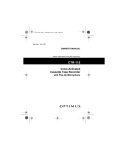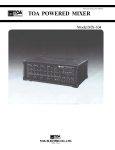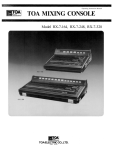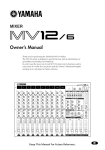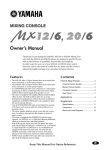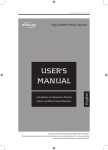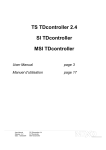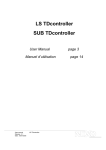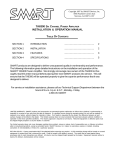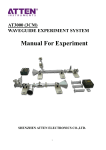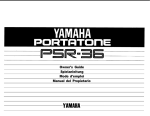Download Viking MCX-106 User's Manual
Transcript
Operating Instruction Manual TOA POWERED MIXER Model MCX-106 TOA ELECTRIC CO., LTD. KOBE, JAPAN Contents General Description Features Front Panel [Input Section] Front Panel [Output Section] Front Panel [Stereo Cassette Recorder Section] Front Panel [Patch Bay & Bus Link] Rear Panel Connection Examples Input Connections How to get a good mix. Recording Level Setting Type of Cassette Tape Maintenance of Stereo Cassette Deck Block and Level Diagrams Specifications Characteristic Diagrams Appearance Precautions 2. Description of components and functions on the MCX-106. D e s c r i p t i o n s may v a r y , d e p e n d i n g on each m a n u f a c t u r e r . In our O p e r a t i n g and I n s t r u c t i o n Manual e x p l a n a t i o n of c o m p o n e n t s and f u n c t i o n s is made a c c o r d i n g t o our usage f o r t h e m . 1. XLR Type Audio Connector The connectors are wired as follows. The pin 1 is ground ( s h i e l d ) , t h e pin 2 cold (low, m i n u s ) , the pin 3 hot (high, p l u s ) . MCX-106™ Operating Guide 6. 7. 8. 9. 10. A Few Words about design: The MCX™ is q u i t e an u n u s u a l p r o d u c t , b u t t h e reasoning behind its design was q u i t e simple . . . . we wanted to i n t e r g r a t e all t h e basic c o m p o n e n t s of a sound reinforcement system and a recording s t u d i o i n t o a single, t r a n s p o r t a b l e package. The 1. 2. 3. 4. 5. One-octave equalizer. Patch bay. Headphone c u e / m o n i t o r s y s t e m . Three-hundred w a t t power a m p l i f i e r . Road case. Each of t h e s e " c o m p o n e n t s " f u n c t i o n s i n d e p e n d e n t l y of t h e o t h e r s , a l t h o u g h some do share common signal processing and c o n t r o l c i r c u i t r y . For example, t h e main mixer, e f f e c t s m i x e r , and recording mixer all m a k e use of t h e same i n p u t e q u a l i z a t i o n on each of t h e six c h a n n e l s . And t h e i n p u t t r i m c o n t r o l p e r f o r m s t h e same f u n c t i o n for a l l f o u r m i x i n g s e c t i o n s . basic components of the MCX™ are as f o l l o w s : Six-channel main mixer. Six-channel o n - s t a g e m o n i t o r mixer. Six-channel special e f f e c t s mixer. Six-channel recording mixer. Stereo t a p e deck. — 1 — General Description The MCX-106 is a compact self-powered mixer with a Microprocessor c o n t r o l l e d stereo cassette deck, designed to allow recording a live demo tape, p e r f o r m i n g to pre-recorded program m a t e r i a l , recording sound on sound with an e x t e r n a l tape source, and simultaneously performing as a six-channel "powered" main sound system and a sixchannel independent m o n i t o r mixer. The MCX-106 fe a tu re s: six i n p u t channels, a 300 w a t t power a m p l i f i e r , 9-band graphic equalizer, a u t o m a t i c compressor, reverb e f f e c t , f l u o r e s c e n t b a r g r a p h m e t e r , power a m p l i f i e r p r o t e c t i o n c i r c u i t r y , and a c o m p l e t e p a t c h bay. Each input channel features: i n p u t t r i m c o n t r o l w i t h LED peak i n d i c a t o r , pre-EQ f o l d b a c k send, 3-band EQ, post-EQ recording level and pan controls, p o s t - r e v e r b / e f f e c t s send, LoZ balanced XLR input and Hi-Z unbalanced 1/4" i n p u t . The built-in cassette deck f e a t u r e s : f u l l logic cassette mechanism c o n t r o l , dbx noise reduction system, zero r e t u r n and cue f u n c t i o n s , a u t o m a t i c tape selector. All these u n i q u e f u n c t i o n s are i n t e g r a t e d into a ruggedly c o n s t r u c t and p o r t a b l e package, offering unlimited applications for school, church, band, performing group, etc. The MCX-106 is a "first of its kind" product, providing such a wide variety of versatility. Features Each Channel 1. Built-in Stereo Cassette Recorder with microprocessor control 1. Input Trim Control with LED peak indicator 2. Six Input Channels 2. Pre-EQ f o l d b a c k send 3. 300 watt Power A m p l i f i e r 3. 3-Band EQ 4. 9-band Graphic Equalizer with Bypass Switch 4. Post-EQ recording level and pan controls 5. Auto-Comp™ Compression Circuitry with LED indicator 5. Post r e v e r b / e f f e c t s send 6. Lo-Z Balanced XLR Input 6. Reverberation Effect with 2-band dedicated EQ 7. Hi-Z Unbalanced 1/4" I n p u t 7. Fluorescent Bargraph Metering— assignable Stereo Cassette Recorder 8. Power Amp Protection Circuitry with indicator 1. Full Logic Cassette Mechanism Control 9. Complete patch Bay with Buss-Link™ 10. Aux. Input with Stereo Balance and Level Controls — assignable to PGM, FB, and Rec L & R Busses 2. dbx® Noise Reduction System 11. Headphone Monitoring/Cueing System 4. Headphone O u t p u t w i t h Level Control 12. Independent Stage Monitor (FB) Mix 5. Tape Transport Remote Control ( s t a r t / s t o p ) 3. A u t o m a t i c Tape Selector with Indicator (normal, CrO 2 Metal) 6. Tape Pitch Control (±10%) 7. Zero R e t u r n w i t h A u t o m a t i c Cue 8. 3-Digit Tape C o u n t e r —2— Front Panel, Input Section Foldback Control (FB) The Foldback control determines the level of signal assigned to the foldback mixing buss, thus s e t t i n g the level of t h a t channel in t h e on-stage m o n i t o r mix. Peak Indicator (PEAK) The peak i n d i c a t o r lights when t h e pre or post EQ signal level reaches 3dB below c l i p p i n g , giving a visual reference for o p t i m u m s e t t i n g of t h e t r i m control. High Equalizer Control (HIGH EQ) The high EQ control alters the high frequency response of t h e i n p u t channel, providing ±13dB at 10kHz, and ±15dBat 20kHz of continuously variable a c t i v e shelving equalization. The "0" detented position provides f l a t audio response. Recording pan Pot (REC PAN) This control assigns t h e recording signal from each channel to Middle Equalizer Control (MID EQ) The mid EQ control provides ±15dB of c o n t i n u o u s l y variable t h e recording L and R mixing busses. At the center position, t h e pan pot routes the signal equally to the L and R mixing busses. Panning from one side to t h e other gradually assigns t h e i n p u t signal to e i t h e r the recording L or R mixing bus exclusively! active peaking e q u a l i z a t i o n at 2kHz. and has a flat audio response when set to t h e "0" detented position. Low Equalizer Control (LOW EQ) The low EQ control provides ±13dB at l00Hz and ±15dB at 50Hz (of c o n t i n u o u s l y v ariable a c t i v e shelving e q u a l i z a t i o n . The "0" detented position provides f l a t audio response. Recording Level J Control (REC LEVEL) This control a d j u s t s the level of signal assigned t o t h e tape deck v i a t h e recording pan pot and stereo L and R recording busses. R o t a t i n g t h e control clockwise increases t h e a m o u n t of signal assigned to t h e recording L and R busses and t h u s the level of t h a t i n p u t in t h e "recording mix." Reverb/Effects Control (REV/EFF) This c o n t r o l d e t e r m i n e s the? level of signal assigned to the reverb effects buss. R o t a t i n g the c o n t r o l clockwise increases t h e a m o u n t of reverb e f f e c t in t h a t channel. Low Impedance Connectors (LOW Z) The XLR connectors are low impedance, e l e c t r o n i c a l l y balanced i n p u t s w i t h an i n p u t impedance of 1k ohms. Input Trim Control (TRIM) The i n p u t t r i m a d j u s t s the gain of t h e head-amp stage of the associated channel, providing 39 dB of gain c o n t r o l . When t h e t r i m c o n t r o l is set to t h e "10" p o s i t i o n , t h e n o m i n al i n p u t levels of t h e low-Z and high-Z i n p u t s are — 55dB and —35dB respectively. At t h e "0" position the levels are -16dB and +4dB. The t r i m of each channel should be a d j u s t e d so t h a t the peak LED j u s t begins to l i g h t , or only flashes occasionally. This will ensure lowest d i s t o r t i o n levels and o p t i m u m signal to noise ratio. High Impedance Connectors (HIGH Z) These connectors are u n b a l a n c ed, s t a n d a r d 1/4" phone j a c k s w i t h an i n p u t impedance? of 50k ohms, and an i n p u t level of —35dB when t h e t r i m c o n t r o l is set t o "10". When a plug is i n s e r t ed i n t o t h e high —Z i n p u t , t h e corresponding XLR c o n n e c t o r is a u t o m a t i c a l l y s w i t c h e d o u t of the i n p u t c i r c u i t r y . — 3 — Input Level Control (INPUT LEVEL) The level c o n t r o l provides cont i n u o u s l y variable adjustment of t h e c h a n n e l o u t p u t to t h e program mixing buss, thus det e r m i n i n g t h e level of t h a t c h a n n e l in t h e main sound s y s t e m mix. Since t h e reverb/ e f f e c t s signal is "post" t h i s control, an increase in t h e level of t h e channel's o u t p u t w i l l also result in a corresponding increase in he reverb e f f e c t of t h a t channel. The n o m i n a l level of the i n p u t level c o n t r o l is at t h e "10" position. Front Panel, Output Section Aux Recording Balance (AUX REC BAL) This c o n t r o l a d j u s t s t h e level balance of t h e a u x in, L and R signals r o u t e d t o t h e L and R m i x i n g busses. At t h e center p o s i t i o n , t h e balance control routes the signal e q u a l l y to t h e L and R m i x i n g busses. Auxiliary Input Recording Level Control (AUX REC LEVEL) This control sets t h e level of stereo L and R signal ( f r o m an e x t e r n a l source connected to t h e AUX INPUT) assigned to t h e recording busses, via t h e AUX REC BAL control. Auxiliary Input to Foldback Control ((AUX TO FB) This control sets the level of aux i n p u t signal assigned to the foldback mixing bus, and t h u s t h e level of the e x t e r n a l aux source in t h e on-stage m o n i t o r mix. NOTE: If t h e aux source is a stereo L and R signal (for example, a stereo cassette player) t h e L and R will be combined i n t o one mono signal before assignment to either the FB or PGM mixing busses. Reverberation High Equalizer — Control (REV HIGH EQ) The high EQ c o n t r o l a l t e r s t h e high frequency response? of t h e r e v e r b e r a t i o n s i g n a l . The "0" det e n t e d p o s i t i o n provides f l a t a u d i o response. Recordig Level Control (EFF REC LEVEL) - Reverberation Low Equalizer Control (REV LOW EQ) The low EQ c o n t r o l a l t e r s t h e low f r e q u e n c y response of t h e r e v e r b e r a t i o n s i g n a l . The "0" det e n t e d p o s i t i o n provides f l a t audio response. - Playback to Program Control (TAPE TO PGM) This c o n t r o l a d j u s t s t h e level of p l a y b a c k signal r o u t e d t o t h e program m i x i n g buss, and t h u s the level of t h e i n t e r n a l tape? source in t h e m a i n m i x . This c o n t r o l sets t h e level of reverb (or e x t e r n a l e f f e c t s ) in t h e recording mix, via the e f f e c t s return pan pot. Effect Recording Pan Control (EFF REC PAN) Playback to Foldback Control (TAPE TO FB) This c o n t r o l a d j u s t s t h e level of This c o n t r o l assigns t h e reverb or external effects signal to t h e recording L and R mixing busses. In t h e center "detended" p o s i t i o n , the signal is assigned e q u a l l y to L and R; panning t h e c o n t r o l g r a d u a l l y assigns t h e e f f e c t t o either bus exclusively. p l a y b a c k signal t o t h e f o l d b a c k m i x i n g buss, and t h u s t h e level of t h e i n t e r n a l t a p e in t h e onstage m o n i t o r mix. Reverb/Effects to ProgramControl (EFF TO PGM) This control a d j u s t s t h e a m o u n t of r e v e r b / e f f e c t s signal t h a t is r e t u r n e d t o t h e program buss and t h u s t h e level of reverb/ e f f e c t s c o n t a i n e d in t h e main sound system. Reverb/Effects Send Control (REV/EFF SEND) This c o n t r o l a d j u s t s t h e overall signal level of t h e e f f e c t s mix t h a t is delivered t o t h e i n t e r n a l reverberation u n i t , or to an e x t e r n a l e f f e c t s device t h r o u g h t h e e f f e c t s o u t p u t . The send cont r o l works in c o n j u n c t i o n w i t h t h e REV/EFF t o PGM and t h e REV/EFF to FB controls to set t h e overall level of reverb/ e f f e c t s in t h e main and m o n i t o r sound systems. The FB m a s t e r c o n t r o l a d j u s t s t h e o v e r a l l combined signal level of the six independent channel foldback sends, and t h u s t h e level of t h e e n t i r e onstage m o n i t o r mix. Program Master Control (PGM) The PGM c o n t r o l a d j u s t s t h e overall combined signal level of t h e six independent channel level controls, and t h u s the level of t h e m a i n sound system. Graphic Equalizer (EQUALIZATION) The graphic equalizer is 1/1 octave w i t h 9 independent active bands ( f i l t e r s ) , providing 12dB of boost or cut at each center frequency. The "0" d e t e n t e d posit i o n provides f l a t audio response. Graphic Equalizer In/Out Switch (IN/OUT) The i n / o u t switch enables comparison between a flat response ( o u t ) and t h e equalized response ( i n ) . The "out" position completely removes the equalizer from t h e MCX-106 circuitry. Phones Level Control (PHONES) The phones level c o n t r o l a d j u s t s both the recording L and R signals fed to t h e phones o u t p u t and p e r m i t s recording and p l a y b a c k m o n i t o r i n g . Auxiliary Input to Program Control (AUX TO PGM) This c o n t r o l sets t h e level of aux i n p u t signal assigned to t h e program mixing bus, and t h u s the level of the external aux source in the main mix. Effect to Foldback Control (EFF TO FB) This control determines t h e level of reverb/effects r e t u r n signal assigned to t h e foldback mixing buss, and t h u s t h e amount of e f f e c t s in the on-stage m o n i t o r mix. Foldback Master Control (FB) Headphone Jack The headphone jack will accept any stereo headphone w i t h 8 ohms impedance, or higher. Buss Link Jack (BUSS LINK) Patching Jack (PATCH BAY/OUT) Patching Jack (PATCH BAY/IN) Tape Deck Remote Control (TAPE REMOTE) This j a c k remotely operates t h e tape PAUSE f u n c t i o n d u r i n g recording or playback by means of a foot switch. -Aux Input L and R (AUX IN, L, R) The aux L and R 1/4" phone jacks are unbalanced and a c c e p t low and high impedance sources at n o m i n a l —20 dB level. The jacks are wired w i t h t h e corresponding L and R pin jacks in parallel. When a plug is i n s e r t e d in t h e phone ja c k , th e pin ja c k is a u t o m a t i c a l l y switched out of Playback Output Pin Jack (TAPE OUT) The playback o u t pin j a c k o b t a i n s i t s signal from t h e i n t e r n a l tape deck. Nominal o u t p u t level is 0dB dB w i t h an impedance o f 1k ohms. t h e aux i n p u t c i r c u i t r y . The a u x i n p u t is i n t e n d e d p r i m a r i l y for e x t e r n a l m u s i c sources such as cassette t a p e players, radio receivers, or record players. NOTE: A phonograph w i t h m a g n e t i c c a r t r i d g e requires the use of a p r e amp w i t h RIAA e q u a l i zation. Recording Output Pin Jack(REC OUT) The REC out pin j a c k derives i t s signal from t h e recording L and R m i x i n g busses, and is i n t e n d e d for c o n n e c t i o n t o e x t e r n a l r e cording e q u i p m e n t . N o m i n a l o u t p u t level is —10 dB w i t h an impedance o f 1k ohms. —4— Power Amp CompressionIndicator (COMP) The comp LED l i g h t s when t h e i n t e r n a l compressor is a c t i v a t ed. The compressor is p r o v i d e d to p r o t e c t speaker systems by compressing t h e i n p u t signal level of t h e power a m p l i f i e r when clipping occurs in the o u t p u t stage. Frequent f l a s h i n g of t h e LED is not reason for a l a r m . H o w e v e r . a c o n s t a n t or s t e a d y l i g h t i n d i c a t e s t h a t t h e MCX-106 is b e i n g overdriven and t h a t t h e i n t e r n a l power a m p l i f i e r is possibly "under powered" (or t h a t a p p l i c a t i o n . The o u t p u t l e v e l of t h e ; MCX-106 should be; decreased u n t i l the LED o nly flashes intermittently. Power Amp Protection Indicator (PROTECT) The indicator LED lights if t h e power a m p l i f i e r o u t p u t is shorted, if the t e m p e r a t u r e of the u n i t rises above acceptable levels, or if DG is d r i f t e d to the speaker o u t p u t s . If t h e LED should l i g h t , speaker wiring and ambient t e m p e r a t u r e of t h e MCX-106 should be checked. If the LED remains l i g h t e d , the u n i t should be referred to q u a l i f i e d service personnel for repair. Note: The MCX-106 p r o t e c t i o n circ u i t r y w i l l (1) detect ' f a u l t y cond i t i o n s ' w i t h i n t h e power ampl i f i e r , ( 2 ) give a visual indication, and (3) a u t o m a t i c a l l y shut down u n t i l t h e ; f a u l t condition is a l l e v i a t e d . This special c i r c u i t r y e n s u r e s maximum reliability and v i r t u a l l y eliminates equipm e n t damage due t o unsafe or f a u l t conditions. Please refer t o f a u l t p r o t e c t i o n t a b l e on page 9 for f u l l e x p l a n a t i o n of t h i s important feature. Front Panel Stereo Cassette Deck Section Counter Reset Button Resets the tape couter t o "000". Tape Counter Indicates how far t h e tape has travelled. Tape Indicator Indicates the type of t a p e used. (The deck a u t o m a t i c a l l y selects the type of tape. NORMAL, CrO2, METAL) Cassette Receptacle Cue Indicator R e m a i n s l i t d u r i n g o p e r a t i o n of t h e Cue f u n c t i o n . DBX Indicator L i g h t s when t h e dbx noise; r e d u c t i o n c i r c u i t r y is a c t i v a t e d . Zero Return Switch This s w i t c h selects t h e zero r e t u r n f u n c t i o n . In t h e "on" p o s i t i o n t h e t a p e w i l l rewind and stop at any point on t h e t a p e t h a t you d e s i g n a t e as "zero". Pitch Control (PITCH CONTROL) Varies the tape transport speed during playback by ±10%. Mute Button Pressing and holding the m u t e b u t t o n during tape travel (while in the recording mode) will provide a "silent" section on t h e tape for use w i t h the cuing f u n c t i o n ; releasing t h e b u t t o n will restore selected recording levels. It is essential t h a t the "muted" section c o n t i n u e for at least four seconds to enable t h e cue f u n c t i o n to operate correctly. Recording Button Pressing b o t h t h e PLAY and t h i s b u t t o n p u t s u n i t in t h e recording mode. enables or disenables t h e i n t e r nal dbx noise r e d u c t i o n f e a t u r e in e i t h e r t h e playback or recording modes. Cue Button Pressing t h i s b u t t o n and the FAST FORWARD or REWIND b u t t o n w i l l rewind t h e tape t o t h e n e x t "muted" or unrecorded s e c t i o n ( t a p e silence of f o u r seconds or more), where t h e deck w i l l a u t o m a t i c a l l y stop. Level Meter Selector Switch The l e f t position monitors the PGM and FB o u t p u t levels; t h e right position monitors the i n t e r n a l t a p e p l a y b a c k and recording levels. Eject Button (EJECT) Ejects the tape. Pause Button This b u t t o n is used t o stop t h e t a p e t r a v e l t e m p o r a r i l y during recording or playback. DBX Button Pressing t h i s b u t t o n a l t e r n a t e l y Fluorescent Bargraph Meter The high i n t e n s i t y meters enable v i s u a l m o n i t o r i n g of t h e o u t p u t signals selected w i t h t h e Level Meter Selector Switch. Recording Level Sliders Sets t h e overall signal level of t h e stereo L and R recording busses d u r i n g t h e recording process; t h i s includes t h e level assigned t o t h e ; REC OUT jacks as well as t h e ; i n t e r n a l tape deck. Rewind Button Rewinds t h e t a p e at high speed. Fast Forward Button Advances t h e ; t a p e at highspeed. Stop Button Stops t h e t a p e m o t i o n . Playback Button This b u t t o n is used t o p l a y b a c k t h e tape;. — 5 — Front Panel, Patch Bay & Buss Link Effects Return Jack (EFT/RET) The EFF/RET j a c k is provided t o connect an e x t e r n a l e f f e c t s device to t h e MCX-106. When a plug is inserted t h e i n t e r n a l r e v e r b e r a t i o n u n i t is a u t o m a t i cally s w i t c h e d o u t of t h e MCX106 c i r c u i t r y , being replaced by the e x t e r n a l u n i t . This j a c k should be connected to t h e o u t p u t of the e x t e r n a l e f f e c t s u n i t . N o m i n a l i n p u t level is —20dB w i t h an impedance of 50k ohms. Graphic Equalizer Input Jack (GEQ) The GEQ i n p u t j a c k allows t h e graphic e q u a l i z e r t o be used independently of t h e MCX-106 w i t h other external equipment, or t h e i n t e r n a l power a m p l i f i e r and t h e g r a p h i c e q u a l i z e r w i t h e x t e r n a l e q u i p m e n t . When a plug is i n s e r t e d , t h e m a i n mix from t h e program buss is disconnected from t h e g r a p h i c e q u a l izer and t h e power a m p l i f i e r . The n o m i n a l i n p u t level is —4dB w i t h an i n p u t impedance of 50k ohms. Power Amplifier Input Jack (PWR) The PWR Amp i n p u t j a c k allows t h e i n t e r n a l power a m p l i f i e r t o be used w i t h e x t e r n a l e q u i p m e n t . When a p l u g is i n s e r t e d , t h e power amp is a u t o m a t i c a l l y disconnected from t h e MCX-106 m i x e r s e c t i o n . The n o m i n a l inp u t level is +4dB w i t h an i n p u t i m p e d a n c e of 10k ohms. Program Buss Link Jack (PGM) (+4dB 22k ) Fold Back Buss Link (FB) (+4dB 22k ) Effects Output Jack (EFF) The EFF Out j a c k used in conj u n c t i o n w i t h t h e EFF/RET Jack allows use of an e x t e r n a l e f f e c t s device in place of t h e i n t e r n a l Reverb/Effects Buss Link Jack (EFF) (+4dB 22k ) Buss Link Jacks The buss l i n k provides direct access t o t h e PGM, FB, and eff e c t s m i x i n g busses, and is provided for easy i n p u t expansion w i t h a d d i t i o n a l MCX-106 u n i t s or o t h e r a u x i l i a r y equipment. All jacks have an i n p u t level of +4dB w i t h an impedance of 22k ohms. reverberation u n i t . The e f f e c t s o u t j a c k should be connected to t h e i n p u t of t h e e x t e r n a l e f f e c t u n i t . Nominal o u t p u t level is — l 0 d B w i t h an impedance of 600 ohms. Program Output Jack (PGM) The PGM Out jack is provided for connection to e x t e r n a l equalizers and/or power amps, deriving i t s signal prior to t h e i n t e r n a l GEQ and power amp. N o m i n a l o u t p u t level is +4dB w i t h an impedance of 600 ohms. - Foldback Output Jack (FB) - Graphic Equalizer Output Jack (GEQ) This j a c k allows t h e MCX-106 and t h e i n t e r n a l graphic equalizer to be used w i t h an e x t e r n a l power a m p l i f i e r , or in c o n j u n c t i o n w i t h t h e GEQ in j a c k , t o be used i n d e p e n d e n t l y of all o t h e r MCX-106 c i r c u i t r y . N o m i n a l o u t p u t level is +4dB w i t h an i m p e d a n c e of 600 ohms This j a c k is for c o n n e c t i o n t o e x t e r n a l power a m p l i f i e r s a n d / or e q u a l i z e r s for t h e o n - s t a g e m o n i t o r i n g system. N o m i n a l o u t p u t level is +4dB w i t h an impedance of 600 ohms. I f t h e i n t e r n a l power amp and e q u a l izer are t o be used for t h e onstage m o n i t o r s y s t e m , t h e FB o u t p u t should be connected t o the GEQ i n p u t j a c k . Rear Panel Power Switch (POWER) The power s w i t c h is a threep o s i t i o n t y p e w i t h the m i d d l e position being the "off" position. The MCX-106 should be o p e r a t ed in t h e s w i t c h p o s i t i o n w h i c h produces t h e lowest a m o u n t of system h u m . Cord Wrap The cord wrap is provided for c o n v e n i e n t storage of t h e power cord when t h e MCX-106 is not in use. Caution - The power cord should a l w a y s be c o m p l e t e l y removed from t h e cord wrap prior to o p e r a t i o n of t h e u n i t . This w i l l i n s u r e m a x i m u m cooling of t h e MCX-106. For t h e same reason, a d e q u a t e clearance should be m a i n t a i n e d between the rear panel and any o t h e r surface (4-6 inches should do). The v e n t s on t h e b o t t o m and top of t h e MCX106 are also provided for convect i o n cooling. These vents should be k e p t clear and open. Failure t o do so may cause t h e r m a l s h u t down of t h e u n i t . Speaker Jacks (SPEAKERS) The speaker o u t p u t s are s t a n d ard 1/4" phone j a c k s wired in p a r a l l e l . Speaker cables (recommend at least #18 gauge w i r e ) should be connected b e t w e e n t h e MCX-106 and t h e speaker s y s t e m s prior t o a p p l y i n g power to t h e u n i t . Caution - The MCX-106 s h o u l d never be o p e r a t e d i n t o less t h a n a 2 ohm speaker load. Earth Terminal (GND) AC Power Cord The power cord is t h e t h r e e - w i r e t y p e w i t h proper g r o u n d i n g f a c i lities. Caution - The g r o u n d pin s h o u l d n o t be removed u n d e r a n y c i r c u m s t a n c e s . I f t h e MCX-106 m u s t be used w i t h o u t proper grounding f a c i l i t i e s , a s u i t a b l e g r o u n d i n g a d a p t e r s h o u l d be AC Fuse u t i l i z e d . O p e r a t i o n of t h e MCX106 w i t h proper g r o u n d i n g t e c h n i q u e s w i l l r e s u l t in less s y s t e m noise and g r e a t l y reduced shock h a z a r d . Warning - To a v o i d p o s s i b l e e q u i p m e n t damage and or personnel i n j u r y , t h e f u s e s h o u l d a l w a y s b e replaced w i t h same t y p e and r a t i n g . U s i n g i m p r o p e r fuses will also void the warran- — 6 — t y . The MCX-106 s h o u l d a l w a y s be d i s c o n n e c t e d f r o m AC o u t l e t p r i o r t o c h a n g i n g fuses. If fuse r e p e a t e d l y f a i l s , t h e u n i t should be r e f e r r e d t o q u a l i f i e d service personnel lor repair. Connection Examples Low Z i n p u t should be connected w i t h low impedance (50 ohm ~ 600 ohm) microphones SUB MIXER (MCX-106) B u i l t in Power A m p l i f i e r for Foldback From Speaker Jack on Rear Panel MAIN MIXER (MCX-106) WIRELESS TUNER SUCH AS WT-02, WT-06 From Speaker J a c k on Rear Panel HEAD PHONES KEYBOARD TAPE DECK REMOTE CONTROL FOOTSWITCH MUSICAL INSTRUMENT MAIN SPEAKER SYSTEM SPEAKER SYSTEM for f o l d b a c k — 7 —_ _ Input Connections Generally speaking, there are two rules to follow when connecting equipment outputs to the inputs of other equipment. 1. Properly match the impedances of the outputs and inputs. 2. Connect low impedance outputs to high impedance inputs. It goes without saying that not only input and output impedance matching but also level matching should be taken into consideration. Each input channel of the MCX106 is provided with an input TRIM control, so the usable signal level range is very wide. Input impedances and levels are shown in the following table. INPUT SPECIFICATIONS CONNECTION INPUT ACTUAL LOAD IMPEDANCE CH1 LOW Z OPEN CH6 HIGH Z FOR USE WITH NOMINAL MICROPHONES LOWER IMP LINES TRIM POSITION SENSITIVITY (PGM OUTPUT LEVEL +4dB) MAX BEFORE CLIP INPUT LEVEL 10 -55dBm (1.38mV) -34dBm (15mV) 0 -16dBm (123mV) +1.7dB (0.94V) 10 -35dBm (13.8mV) -14dBm (150mV) +4dBm (1.23mV) +20dB (7.75V) CONNECTOR XLR TYPE NC3F PHONE JACK 0 AUX (L & R) —— LOWER IMP, LINES -l0dBm (245mV) +8dBm (1.9V) PHONE JACK RCA PIN JACK EFF/RET —— LOWER IMP, LINES -20dBm (77.5mV) -2dBm (0.61V) PHONE JACK GEQ —— LOWER IMP, LINES +4dBm (1.23V) PHONE JACK +4dBm (1.23V) PHONE JACK PWR BUSS LINK (PGM, FB, EFF) —— —— +4dBm (1.23V) LOWER IMP LINES +20 dBm (7.75V) PHONE JACK *Sensitivity is the level required to produce a program out level of +4dBm. *0dBm is referenced to 0.775V RMS. All XLR Type connectors are electronically balanced (transformer less). Phone jack is unbalanced. If the line going from one piece of equipment to another is long (more than 5m), we recommend that balanced outputs be connected to balanced inputs. As is described in the beginning of the Operating Instructions Manual, the connectors of the MCX-106 are wired as follows: Pin 1 is ground (shield). Pin 2 is cold (low, minus). Pin 3 is hot (high, plus). —8 — How to get a good mix Before connecting other equipment to the Powered mixer, check the impedance and level of both. If the impedances and levels do not match, mixing will be very difficult and the S/N ratio will also be adversely affected. If the trim control is set as shown in the l e f t figure, the i n p u t level controls can be set to the same position. The input level controls are used in general between 6 and 8. Each input channel of the MCX-106 is provided with a TRIM control. Thorough understanding of the function of a TRIM control will make mixing easier. The peak indicator LED illuminates if the head amplifier or equalizer is clipping. The gain of the head-amplifier must be decreased by t u r n i n g the trim control counterclockwise. The function of the TRIM control is to control the negative feedback volume of the head-amp so that the gain of the head-amp can also be changed. Because of this, enough dynamic range, even for high level signals is ensured. Also, the S/N ratio will be better by decreasing the gain of the head-amp. For example, a keyboard, a musical instrument and a dynamic microphone with output levels of —l0dBm, -20dBm and -40dBm respectively are connected to the MCX-106. Key Board in —l0dBm level Musical Instrument in —20dBm level Dynamic Microphone in -40dBm level Fault Protection Table Fault Excessive current due to overloads. Short circuits (less than 0.4-ohm) Temperature rise of heat sink (more than 105°C) DC drift Protection Indication Current limiter activates at less than 1 ohm. Compressor LED illuminates. Current limiter activates, input signal is lowered, unit shuts down. Input signal is lowered. Unit shuts down. Amp protection LED illuminates. Action Remove excessive lords. Minimum speaker loads 2ohm. Check speaker lines/systems for shorts. Amp protection LED illuminates. Check for adequate ventilation. Input signal is lowered. Unit shuts down. Amp protection LED illuminates. Refer to qualified service personnel. Restoration Automatic restoration after normal loads are obtained. Turn off power switch. Turn on into operational loads. Automatic restoration after temperature lowers (to 75° - 95°C) A u t o m a t i c restoration after normal bias is regained. Recording Level Setting The following procedures are recommended f o r an accurate and h i g h - q u a l i t y recording. 1. Place the level meter selection switch in the "Tape" position. 2. Engage the noise r e d u c t i o n c i r c u i t r y by pressing t h e dbx switch. an "encode/decode" process, m e a n i n g t h a t any tape t h a t is recorded w i t h dbx m u s t also be played back w i t h dbx, to o b t a i n s a t i s f a c t o r y r e s u l t s . If the recording must be p l a y e d on o t h e r e q u i p m e n t w i t h o u t dbx c i r c u i t r y , we r e c o m m e n d t h a t the dbx f e a t u r e not be used. NOTE: Using the internal dbx c i r c u i t r y will provide higher q u a l i t y recordings with excellent "signal-to-noise" characteristics. You will notice a drastic r e d u c t i o n in audible "tape hiss" and a s i g n i f i c a n t increase in dynamic range. However, the dbx noise r e d u c t i o n is 3. Press the record b u t t o n to p l a c e t h e deck in "record pause" mode. 4. A d j u s t the L and R m a s t e r recording level sliders to a level j u s t below the "red" in t h e b a r g r a p h meters. 5. Press PLAY b u t t o n to b e g i n r e c o r d i n g . — 9 — Types of Cassette Tape Types of cassette tape Type C-30 openings with adhesive tape if you desire to erase or record the tape at a later date. m i c r o n : 1/1000mm C-46 C-60 C-90 C-120 Tape t r a v e l h o u r 30 m i n . 46 min 6 Om i n . 90 m i n . 120 m i n . Tape t h i c k n e s s 18 m i c r o n 18 m i c r o n 18 m i c r o n 12 m i c r o n 9 micron Hints on Cassette Tape Handling 1. Tape Slack can cause the tape to twist or break. When necessary, always t a k e up slack by inserting a pencil or similar o b j e c t into the reel hub and turning. 2. Winding the tape too t i g h t l y on the reel may cause the tape to rotate u n e v e n l y ; in worst case, the tape may bind and not wind f r o m reel to reel. Before using a tape again a f t e r c o n t i n u o u s playback or recording, lightly tap the cassette housing or both sides, and if necessary, rewind the tape in either the f a s t - f o r w a r d or re-wind mode. CAUTION: A C-120 tape is so thin t h a t it can be easily s t r e t c h e d , causing tape slack and possible entanglement around the pinch roller and capstan. We do not recommend the use of C-120 cassette tapes. NOTE: The MCX detects the type of tape ( N o r m a l , CrO 2 , Metal) when the cassette is inserted and the door is latched, automatically selects the proper EQ and bias settings, and gives a visual indication on the front panel. For highest quality recordings and extended dynamic range, we recommend the use of metal tape whenever possible. Storing Tapes Always store cassette tapes in their cases with a protective insert over the exposed portion of the tape; if not available, a t t a c h a "stopper" made f r o m paper as SAVING YOUR RECORDINGS Cassette tapes are provided with two break-out tabs as shown in figure. To prevent accidental erasure or shown in the illustration. To prevent damage or degradation of recordings, always store tapes in locations free from direct sunlight, high temperature or humidity, and magnetic effects from other electrical equipment, speaker systems, etc. overtaping, break the tabs with a screw-driver or similar tool and remove. You may cover the tab Maintenance of Stereo Cassette Mechanism Cleaning the tape heads NOTE: We recommend removal of the cassette receptacle door prior to the cleaning operation; this will f a c i l i t a t e easy access to all the inner workings of the tape t r a n s p o r t assembly. 1. The cassette door opens when the EJECT b u t t o n is pushed. A f t e r opening, press the door downward (see illustration) to disconnect the "top mounted 3. Clean the rubber parts of the transport assembly with cleaning f l u i d , or alcohol, and wipe dry with a clean, soft cloth. NOTE: If a t r a n s p o r t " L u b r i c a n t " of any kind is used on the metal parts, take care to avoid contact with rubber parts. CAUTION: The tape heads and guides are c a r e f u l l y a d j u s t e d to ensure smooth and accurate tape travel during both recording and play back; DO NOT USE EXCESSIVE FORCE when cleaning: misalignment may result. We r e c o m m e n d t h r o u g h c l e a n i n g of the tape t r a n s p o r t assembly a f t e r every f o u r to six hours of use to ensure o p t i m u m recording and p l a y back p e r f o r m a n c e . detents" which hold the door to the chassis. Now pull outward and away f r o m the main assembly. Place the door aside in a safe location for later cleaning. CAUTION: To prevent damage to the t r a n s p o r t and head assembly, use only c o t t o n swabs or a soft cloth for the cleaning procedure. Demagnetizing the tape heads The recording head will become "magnetized" a f t e r prolonged use. This r e s i d u a l m a g n e t i s m will degrade and possibly d e s t r o y y o u r v a l u a b l e recordings by adding u n w a n t e d noise and d i s t o r t i o n , so it is necessary to f r e q u e n t l y " d e m a g n e t i z e " the heads. There are m a n y i n e x p e n s i v e head demagnetizers a v a i l a b l e ; f o l l o w t h e m a n u f a c t u r e r ' s d i r e c t i o n s for use. 2. Using any good grade of commercially available tape cleaning f l u i d (or an acceptable s u b s t i t u t e such as a l c o h o l ) , t h o r o u g h l y clean the tape heads, tape guides, and all other metal parts in the tape path. — 10 — Block and Level Diagrams BLOCK DIAGRAMS LEVEL DIAGRAM — 11 — Specifications MIXER SECTION Maximum Voltage Gain INPUT to PGM out INPUT to EFF out INPUT to FB out INPUT to REC out INPUT to GEQ out AUX to PGM out EFF/RET to PGM out Frequency Response +0, -3dB 30Hz~20kHz (HIGH Z input TRIM at "0" positio Total Harmonic Distortion 0.05% +4dBm at 1kHz. Hum and Noise (Open) Equivalent Input Noise Equivalent Input Noise All level Controls Minimum PGM Master at MAX and all input level controls minimum PGM Master at MAX and one input level control at MAX -130dBm (20Hz~20kHz -133dBm (IHF A) -102dBm (IHF A) 59dB 45dB 59dB 45dB 59dB 14dB 24dB Equalization 63Hz ±12dB Peaking 125Hz ±12dB Peaking 250kHz ±12dB Peaking 500Hz ±12dB Peaking 1kHz ±12dB Peaking -93dBm (IHF A) -72dBm (IHF A) 2kHz ±12dB Peaking 4kHz ±12dB Peaking 8kHz ±12dB Peaking 16kHz ±12dB Peaking Peak Indicators Red LED on each input channel LED's turn on at 3dB below clipping. INPUT SPECIFICATIONS CONNECTION INPUT ACTUAL LOAD IMPEDANCE CH1 LOW Z OPEN CH6 FOR USE WITH NOMINAL MICROPHONES LOWER IMP LINES HIGH Z TRIM POSITION SENSITIVITY (PGM OUTPUT LEVEL +4dB) MAX BEFORE CLIP INPUT LEVEL 10 -55dBm (1.38mV) -34dBm (15mV) 0 -16dBm (123mV) +1.7dB (0.94V) 10 -35dBm ( 13.8m V) -14dBm (150mV) +4dBm (1.23mV) +20dB (7.75V) CONNECTOR XLR TYPE NC3F PHONE JACK 0 AUX (L & R) LOWER IMP, LINES -l0dBm (245mV) +8dBm (1.9V) PHONE JACK RCA PIN JACK EFF/RET LOWER IMP, LINES -20dBm (77.5mV) -2dBm (0.61V) PHONE JACK GEQ LOWER IMP, LINES +4dBm (1.23V) PHONE JACK PWR LOWER IMP LINES +4dBm (1.23V) PHONE JACK BUSS LINK (PGM, FB, EFF) LOWER IMP LINES +4dBm (1.23V) +20 dBm (7.75V) PHONE JACK OUTPUT SPECIFICATIONS CONNECTION ACTUAL LOAD IMPEDANCE FOR USE WITH NOMINAL NOMINAL OUTPUT LEVEL MAX. BEFORE CLIP CONNECTOR +4dB (1.23V) +20dB (7.75V) PHONE JACK +10dB (245V) +8dB (1.9V) PHONE JACK IMP. LINES +4dB (1.23V) +20dB (7.75V) PHONE JACK FB IMP. LINES +4dB (1.23V) +20dB (7.75V) PHONE JACK REC L & R IMP. LINES -l0dB (7.75V) +8dB (1.9V) RCA PIN JACK TAPE L & R IMP. LINES 0dB (0.775V) +20dB (7.75V) RCA PIN JACK PGM IMP. LINES EFF IMP. LINES GEQ POWER AMPLIFIER SECTION Damping Factor Greater than 200 (1kHz Input Sensitivity +4dBm (1.23V) Input Impedance Frequency Response +0, -1dB 5Hz to 40kHz (200W RMS Rated Power & Load 120W RMS 300W RMS 200W RMS Power Output at Clipping 1% THD, 1kHz 140W RMS 348W RMS 238W RMS Total Harmonic Distortion Less than 0.1% (200mW~200W RMS, 20Hz~20kHz) Typically below 0.05% Compressor Dynamic Range Greater than 26dB Output Connector Phone Jack X2 Power Requirement 600 W 120V AC 50/60Hz Dimensions (WXHXD) 605X371X356mm (23.8X14.6 X14.0) inch Weight 27.2 kg (60 I b s ) Hum and Noise At least 110dB S/N ratio, 20Hz~20kHz At least 113dB S/N ratio IHF-A weighted *0dBm is referenced to 0.775V RMS. Specifications are s u b j e c t to change w i t h o u t notice. — 12 — Specifications STEREO CASSETTE DECK SECTION Mechanism 1 Motor 3 Solenoid Mechanism Control 4 Bit Micro Computer Tape Compact Cassette C-30, C-46, C-60 or C90 Track Format 4-Track, 2-Channel (Stereo) Heads 2 Channel Stereo Recording/Play Back (Permalloy) Erase (Ferrite Double Gap) Tape Speed 1-7/8 ips (4.75 cm/s)±l% Pitch Control ±10% of normal Tape Speed (Play Back Only) Wow & Flutter Less Than 0.08% RMS NAB Weighted Fast Wind Time Less Than 100 seconds (C-60 Tape) Motor Electronically Governor Frequency Response 40 Hz to 12.5 kHz (Metal) (Overall Record/Playback) Noise Reduction *DBX type II (IN/OUT Switchable) Signal to Noise Ratio 70dB *DBX IN 20 Hz~20 kHz 90 dB *DBX IN IHF-A Weighted Total Harmonic Distortion Less Than 3% at 1kHz 0dB Bias Frequency 85kHz Erasure 70 dB at 1kHz *DBX is the registered trademark of DBX incorporated. **Specifications are subject to change without notice. Characteristics Diagrams CASSETTE DECK PLAYBACK RECORDING PLAYBACK NORMAL TAPE NORMAL TAPE — 13 — Characteristics Diagrams HIGH Z IN. TRIM/MIN. & INPUT EQ GEQ POWER AMP POWER BAND WIDTH POWER AMP TOTAL HARMONIC DISTORTION POWER AMP COMPRESSOR REVERBERATION FREQUENCY RESPONSE Appearance — 14 — TOA ELECTRIC CO., LTD. KOBE, JAPAN Printed in Japan 133-02-690-80
















